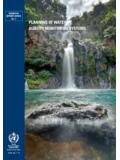Transcription of The WMO STraTegy fOr Service Delivery anD iTS ...
1 The WMO STraTegy for Service Delivery and Its Implementation Plan DESIG. N. SE. RV. ERS. IC. S. EU. ES. G. GA. EN. D I M P R OVE. E. R. IV. N. DEL. TEA. A. U. VAL. E. WMO-No. 1129. WMO-No. 1129. World Meteorological Organization, 2014. The right of publication in print, electronic and any other form and in any language is reserved by WMO. Short extracts from WMO publications may be reproduced without authorization, provided that the complete source is clearly indicated. Editorial correspondence and requests to publish, reproduce or translate this publication in part or in whole should be addressed to: Chair, Publications Board World Meteorological Organization (WMO).
2 7 bis, avenue de la Paix Tel.: +41 (0) 22 730 84 03. Box 2300 Fax: +41 (0) 22 730 80 40. CH-1211 Geneva 2, Switzerland E-mail: ISBN 978-92-63-11129-6. NOTE. The designations employed in WMO publications and the presentation of material in this publication do not imply the expression of any opinion whatsoever on the part of WMO concerning the legal status of any country, territory, city or area, or of its authorities, or concerning the delimitation of its frontiers or boundaries. The mention of specific companies or products does not imply that they are endorsed or recommended by WMO in preference to others of a similar nature which are not mentioned or advertised.
3 The findings, interpretations and conclusions expressed in WMO publications with named authors are those of the authors alone and do not necessarily reflect those of WMO or its Members. The WMO STraTegy for Service Delivery and Its Implementation Plan CONTENTS. PREFACE 5. EXECUTIVE SUMMARY 6. PART I. THE WMO STraTegy FOR Service Delivery 9. PURPOSE OF THE DOCUMENT 10. CHAPTER 1: INTRODUCTION 11. CHAPTER 2: LINK TO THE WMO QUALITY MANAGEMENT FRAMEWORK 12. CHAPTER 3: WHAT IS Service Delivery ? 14. CHAPTER 4: MOVING TOWARDS A Service -ORIENTED CULTURE 16. STraTegy element 1: Evaluate user needs and decisions 16.
4 STraTegy element 2: Link Service development and Delivery to user needs 20. STraTegy element 3: Evaluate and monitor Service performance and outcomes 22. STraTegy element 4: Sustain improved Service Delivery 26. STraTegy element 5: Develop skills needed to sustain Service Delivery 27. STraTegy element 6: Share best practices and knowledge 27. CHAPTER 5: IMPLEMENTATION APPROACH 29. PART II. THE IMPLEMENTATION PLAN FOR THE STraTegy 31. Background 32. Purpose of the Implementation Plan 33. CHAPTER 2: IMPLEMENTATION APPROACH 36. At global level 36. At regional level 36. At national level 37. The Service Delivery Progress Model 37.
5 Advancing to higher levels of Service Delivery 37. CHAPTER 3: IMPLEMENTING THE STraTegy AT NATIONAL LEVEL 38. Steps to implement improved Service Delivery 38. 2. CHAPTER 4: ROLE OF WMO CONSTITUENT BODIES IN IMPLEMENTING THE STraTegy 41. Role of the Executive Council Working Group on Service Delivery 41. Role of the Secretariat 41. Assessment reports 42. Milestones to measure progress of the Implementation Plan 42. The short-term (two-year) time frame 43. The medium-term (six-year) time frame 43. The long-term (10-year) time frame 44. CHAPTER 5: LINKAGES WITH OTHER INITIATIVES AND ACTIVITIES 45.
6 Linkages with WMO initiatives and activities 45. Linkages with the WMO Strategic Plan 45. Linkages with the Global Framework for Climate Services 46. Linkages with the quality management system 46. Linkages to training 47. Linkages to capacity development 47. Linkages with the Madrid Action Plan 48. CHAPTER 6: CLOSING REMARKS 49. PART III. APPENDICES 51. APPENDIX 1: Service Delivery PROGRESS MODEL 52. APPENDIX 2: ACTING ON THE STraTegy ELEMENTS 60. APPENDIX 3: GLOSSARY 63. APPENDIX 4: TOOLKIT OF DOCUMENTS AND TEMPLATES 67. APPENDIX 5: Service Delivery EXAMPLES 117. APPENDIX 6: AN EXAMPLE OF SHARING BEST PRACTICES AMONG NMHSS 119.
7 APPENDIX 7: ACTION PLAN OUTLINE 121. APPENDIX 8: BIBLIOGRAPHY AND FURTHER READING 125. 3. 4. PREFACE. The core business of National Meteorological and Hydrological Services (NMHSs) is built around their responsibility to provide essential weather, climate and related information to the community at large. In the provision of weather-, climate-, water- and environment- related services, it is essential to put the users first. It is only by fully understanding why they need our services and how they use them in their decision-making that we can provide services which are optimal. By striving to provide services that best meet these needs, NMHSs ensure that they fulfil their statutory obligations and are consequently held in high regard by the public, governments and users.
8 Service Delivery lies at the heart of the WMO mission and daily work. The WMO STraTegy for Service Delivery , which is aligned with the WMO Strategic Plan, was approved by the Sixteenth World Meteorological Congress. The STraTegy explains the importance of Service Delivery ; defines the four stages of a continuous, cyclic process for developing and delivering services and the elements necessary for moving towards a more Service -oriented culture; and describes practices to strengthen Service Delivery across the entire WMO. The STraTegy , described in Part I, is considered an essential complement to the Implementation Plan, presented in Part II.
9 The Implementation Plan has been developed to guide NMHSs in assessing and improving their current Service Delivery in line with their strategic objectives. Improving levels of Service Delivery will directly benefit Service users and, as a result, lead to stronger community support for the NMHSs. WMO is committed to developing mechanisms that will assist NMHSs in implementing the WMO. STraTegy for Service Delivery . The Implementation Plan will be published as a recommended practice and will be referenced, as appropriate, in the Technical Regulations (WMO-No. 49). All Members are encouraged to use the Implementation Plan for the WMO STraTegy for Service Delivery to assess where they stand in terms of Service Delivery and continue their efforts to achieve ever higher standards.
10 Michel Jarraud (Secretary-General). 5. EXECUTIVE SUMMARY. WMO Members recognize the importance of providing high-quality Delivery of weather-, climate-, water- and environment- related services. WMO facilitates international coordination, sets standards for meteorological and hydrological products and provides guidance on Service Delivery . While some great success has been achieved in this regard, Members have agreed that a more uniform and structured approach to Service development and Delivery is required. As a result, the WMO STraTegy for Service Delivery (the STraTegy ) was approved at the sixteenth session of the World Meteorological Congress.









